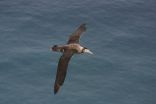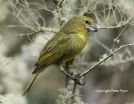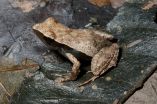A new study shows that a subset of highly threatened species - in this case 841 - can be saved from extinction for about $1.3 billion a year. However, for 15 of them the chances of conservation success are really low.
The study published in Current Biology concludes that a subset of 841 endangered animal species can be saved, but only if conservation efforts are implemented immediately and with an investment of an estimated US $1.3 billion annually to ensure the species' habitat protection and management.
Researchers, led by Assistant Prof. Dalia A. Conde from University of Southern Denmark and Prof. John E Fa from Imperial College, developed a "conservation opportunity index" using measurable indicators to quantify the possibility of achieving successful conservation.
To estimate the opportunities to conserve these species the researchers considered:
1. Opportunities of protecting its remaining habitats, which are restricted to single sites. Important factors are costs, political stability, and probability of urbanization. 2. The possibility to establish protected insurance populations in zoos: Important factors are costs and breeding expertise.
The researchers computed the cost of, and opportunities for, conserving 841 species of mammals, reptiles, birds and amphibians listed by the Alliance for Zero Extinction (AZE) as restricted to single sites and categorized as Endangered or Critically Endangered on the IUCN Red List.
"AZE sites are arguably the most irreplaceable category of important biodiversity conservation sites," said Dr. Dalia A. Conde, lead author on the paper and Assistant Professor at the Max-Planck Odense Center at the University of Southern Denmark, adding:
"Conservation opportunity evaluations like ours show the urgency of implementing management actions before it is too late. However, it is imperative to rationally determine actions for species that we found to have the lowest chances of successful habitat and zoo conservation actions."
While the study indicated that 39% of the species scored high for conservation opportunities, it also showed that at least 15 AZE species are in imminent danger of extinction given their low conservation opportunity index (see list below).
The estimated total cost to conserve the 841 animal species in their natural habitats was calculated to be over US$1 billion total per year. The estimated annual cost for complementary management in zoos was US$160 million.
"Although the cost seems high, safeguarding these species is essential if we want to reduce the extinction rate by 2020," said Prof. Hugh Possingham from The University of Queensland, adding: "When compared to global government spending on other sectors - e.g., US defense spending, which is more than 500 times greater -, an investment in protecting high biodiversity value sites is minor."
Prof. John E. Fa said, "Our exercise gives us hope for saving many highly endangered species from extinction, but actions need to be taken immediately and, for species restricted to one location, an integrative conservation approach is needed."
The paper stated the importance of integrating protection of the places these particular species inhabit with complementary zoo insurance population programmes.
According to Dr. Onnie Byers, Chair of the IUCN SSC Conservation Breeding Specialist Group, "The question is not one of protecting a species in the wild or in zoos. The One Plan approach - effective integration of planning, and the optimal use of limited resources, across the spectrum of management from wild to zoo - is essential if we are to have a hope of achieving the Aichi Biodiversity Targets."
Dr. Nate Flesness, Scientific Director of the International Species Information System, stressed "We want to thank the more than 800 zoos in 87 countries which contribute animal and collection data to the International Species Information System, where the assembled global data enables strategic conservation studies like this."
Dr. Markus Gusset of the World Association of Zoos and Aquariums added "Actions that range from habitat protection to the establishment of insurance populations in zoos will be needed if we want to increase the chances of species' survival."
The 15 species with the lowest chances for survival in the wild and in zoos are:
Amphibians: 1. Bay Lycian salamander, Lyciasalamandra billae, Turkey.
2. Perereca Bokermannohyla izecksohni, Brazil.
3. Campo Grande tree frog, Hypsiboas dulcimer, Brazil.
4. Santa Cruz dwarf frog, Physalaemus soaresi, Brazil.
5. Zorro bubble-nest frog, Pseudophilautus zorro, Sri Lanka.
6. Allobates juanii, Colombia.
Birds: 1. Ash's lark, Mirafra ashi, Somalia.
2. Tahiti monarch, Pomarea nigra, French Polynesia.
3. Zino's petrel, Pterodroma madeira, Madeira.
4. Mascarene petrel, Pseudobulweria aterrima, Reunion Island.
5. Wilkins's finch, Nesospiza wilkinsi, Tristan da Cunha.
6. Amsterdam albatross, Diomedea amsterdamensis, New Amsterdam (Amsterdam Island).
Mammals: 1. Mount Lefo brush-furred mouse, Lophuromys eisentrauti, Cameroon.
2. Chiapan climbing rat, Tylomys bullaris, Mexico.
3. Tropical pocket gopher, Geomys tropicalis.
Their low chance for survival is due to at least two of the following factors: High probability of its habitat becoming urbanized Political instability in the site High costs of habitat protection and management. The opportunity of establishing an insurance population in zoos for these 15 species is low, due to high costs or lack of breeding expertise for the species.
INFORMATION:
Paper Reference: Dalia A. Conde, Fernando Colchero, Burak Gu?neralp, Markus Gusset, Ben Skolnik, Michael Parr, Onnie Byers, Kevin Johnson, Glyn Young, Nate Flesness, Hugh Possingham & John E. Fa (2015): Opportunities and costs for preventing vertebrate extinctions. Current Biology 25(6): R1-R3.
Contact:
Dalia A. Conde, Max-Planck Odense Center, University of Southern Denmark
Email: dalia@sdu.dk
Phone: +45 65502704
John E. Fa, Imperial College
Email: jfa949@gmail.com
Phone: +44 7732161443
Hugh Possingham, The University of Queesland
Email: h.possingham@uq.edu.au
Phone: +61 434 079 061 (txt or email first, travelling all March)




